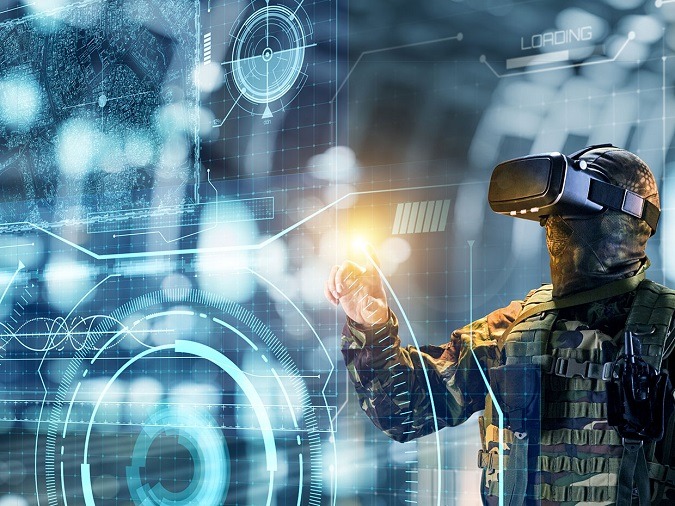Six DARPA-funded research teams aim at revolutionizing noninvasive brain-machine interfaces
 _______
_______
DARPA Funds Ambitious Brain-Machine Interface Program (IEEE Spectrum):
“DARPA’s Next-Generation Nonsurgical Neurotechnology (N3) program has awarded funding to six groups attempting to build brain-machine interfaces that match the performance of implanted electrodes but with no surgery whatsoever.
By simply popping on a helmet or headset, soldiers could conceivably command control centers without touching a keyboard; fly drones intuitively with a thought; even feel intrusions into a secure network. While the tech sounds futuristic, DARPA wants to get it done in four years … The N3 program fits right into DARPA’s high-risk, high-reward biomedical tech portfolio, including programs in electric medicine, brain implants and electrical brain training. And the U.S. defense R&D agency is throwing big money at the program: Though a DARPA spokesperson declined to comment on the amount of funding, two of the winning teams are reporting eye-popping grants of $19.48 million and $18 million.
Plenty of noninvasive neurotechnologies already exist, but not at the resolution necessary to yield high-performance wearable devices for national security applications, says N3 program manager Al Emondi of DARPA’s Biological Technologies Office…“This is uncharted territory for DARPA, and the next step in brain-machine interfaces,” says Emondi. “If we’re successful in some of these technologies…that’s a whole new ecosystem that doesn’t exist right now.”
About the N3 program:
Six paths to the nonsurgical future of brain-machine interfaces (DARPA):
Update: DARPA has awarded funding to six organizations to support the Next-Generation Nonsurgical Neurotechnology (N3) program, first announced in March 2018. Battelle Memorial Institute, Carnegie Mellon University, Johns Hopkins University Applied Physics Laboratory, Palo Alto Research Center (PARC), Rice University, and Teledyne Scientific are leading multidisciplinary teams to develop high-resolution, bidirectional brain-machine interfaces for use by able-bodied service members.
The N3 teams are pursuing a range of approaches that use optics, acoustics, and electromagnetics to record neural activity and/or send signals back to the brain at high speed and resolution. The research is split between two tracks. Teams are pursuing either completely noninvasive interfaces that are entirely external to the body or minutely invasive interface systems that include nanotransducers that can be temporarily and nonsurgically delivered to the brain to improve signal resolution.
- The Battelle team, under principal investigator Dr. Gaurav Sharma, aims to develop a minutely invasive interface system that pairs an external transceiver with electromagnetic nanotransducers that are nonsurgically delivered to neurons of interest. The nanotransducers would convert electrical signals from the neurons into magnetic signals that can be recorded and processed by the external transceiver, and vice versa, to enable bidirectional communication.
- The Carnegie Mellon University team, under principal investigator Dr. Pulkit Grover, aims to develop a completely noninvasive device that uses an acousto-optical approach to record from the brain and interfering electrical fields to write to specific neurons. The team will use ultrasound waves to guide light into and out of the brain to detect neural activity. The team’s write approach exploits the non-linear response of neurons to electric fields to enable localized stimulation of specific cell types.
- The Johns Hopkins University Applied Physics Laboratory team, under principal investigator Dr. David Blodgett, aims to develop a completely noninvasive, coherent optical system for recording from the brain. The system will directly measure optical path-length changes in neural tissue that correlate with neural activity.
- The PARC team, under principal investigator Dr. Krishnan Thyagarajan, aims to develop a completely noninvasive acousto-magnetic device for writing to the brain. Their approach pairs ultrasound waves with magnetic fields to generate localized electric currents for neuromodulation. The hybrid approach offers the potential for localized neuromodulation deeper in the brain.
- The Rice University team, under principal investigator Dr. Jacob Robinson, aims to develop a minutely invasive, bidirectional system for recording from and writing to the brain. For the recording function, the interface will use diffuse optical tomography to infer neural activity by measuring light scattering in neural tissue. To enable the write function, the team will use a magneto-genetic approach to make neurons sensitive to magnetic fields.
- The Teledyne team, under principal investigator Dr. Patrick Connolly, aims to develop a completely noninvasive, integrated device that uses micro optically pumped magnetometers to detect small, localized magnetic fields that correlate with neural activity. The team will use focused ultrasound for writing to neurons.
The News in Context:
- DARPA invests in nonsurgical neurotechnologies for eventual use in healthy human subjects
- DARPA launches Targeted Neuroplasticity Training program to accelerate cognitive skills training
- Neurotechnology can improve our lives…if we first address these Privacy and Informed Consent issues
- Five reasons the future of brain enhancement is digital, pervasive and (hopefully) bright
- 10 neurotechnologies about to transform brain enhancement and brain health


